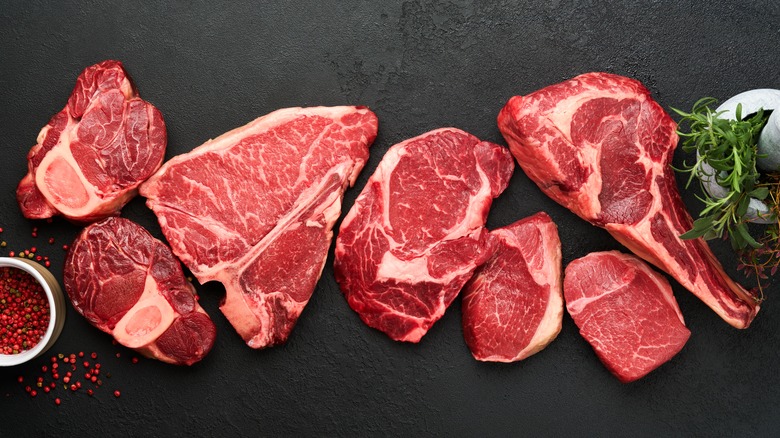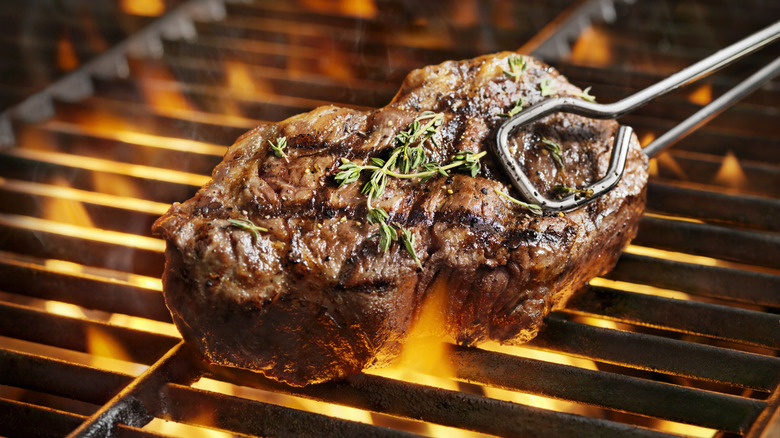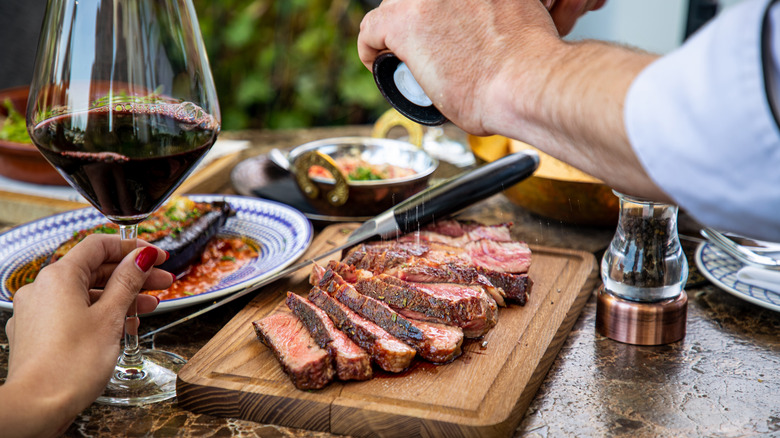When Buying Steaks, Look For Even Thicknesses
When steak night rolls around, you probably have the perfect recipe in mind. Your kitchen or backyard becomes filled with a savory aroma as you sear both sides of the tender meat over the gridiron. Whether you plan to whip up just a couple of helpings or are cooking for a crew, there's one essential feature that shouldn't be overlooked — and it starts at the butcher's station at the market. As you're selecting your filets, sirloins, flanks, or briskets, be sure to carefully compare the depth of each slice. The reasons why are multifaceted — and totally worth it.
Buying steaks with an even thickness is crucial for achieving optimal and consistent cooking results. When purchasing multiple steaks, prioritize cuts that correspond in general size and shape. The rationale behind this lies in the fact that meat, being a protein, cooks at vastly different rates based on its density. Ensuring they're similar sizes eliminates the risk of some pieces finishing while others remain undercooked or, conversely, overcooked.
One primary advantage of cooking steaks with uniform thickness is that it facilitates a harmonized cooking process. Imagine a scenario in which you have various steaks on the same grill or pan. The thinner cuts will naturally cook faster, potentially reaching the desired doneness before their heftier counterparts. This discrepancy in cooking times not only complicates the process but also risks producing inconsistently cooked steaks. The outcome could be a mix of undercooked, perfectly cooked, and overcooked meat, leading to a less-than-ideal dining experience.
Foolproof tips for cooking steaks evenly
Consider a backyard barbecue with friends. You've diligently seasoned and prepared a variety of steaks, carefully selecting prime cuts from the local butcher shop. However, if these cuts differ significantly in thickness, you may find yourself struggling to manage the grill, constantly monitoring each steak to ensure they all reach the desired level of doneness simultaneously. This sounds unnecessarily stressful because it is — but there's a better way.
To guarantee even cooking, a number of tried-and-true steak cooking tips come in handy. For starters, when you're at the butcher shop or grocery store, take a moment to inspect the steaks you plan to take home. If possible, communicate with the butcher to ensure they cut the steaks to your desired thickness. This makes a hassle-free cooking process later.
One reliable cooking method involves bringing the steaks to room temperature before grilling or pan-searing them. This ensures the meat cooks more evenly, as a cold steak straight from the refrigerator may lead to uneven cooking, with the exterior cooking much faster than the interior. As a general rule, allow your steaks to sit somewhere around room temperature for about 30 minutes before cooking.
Another effective steak technique is the reverse-sear method. This involves cooking the steaks at a lower temperature first, allowing them to reach an internal temperature close to the desired doneness. Subsequently, finish the steaks with a high-heat sear to develop a crispy, flavorful crust. This method works particularly well for thicker cuts.
Uniform thickness impacts the steaks' taste and texture
As far as steaks are concerned, establishing as much regularity as possible is not only about convenience; it actually directly impacts the beef's texture and flavor, as well as the time and energy it will take you to rustle up an entire meal, whether for just a couple of people or a large party. For one, even cooking your steaks allows for a lovely, compatible caramelization on the meat's surface, creating that coveted charred look and feel. Additionally, the internal temperature of each slab has a chance to rise homogeneously, yielding a much more juicy (and more flavorful) chew. This consistency ensures that each bite delivers the same succulence and tenderness, contributing to an overall enjoyable dining experience.
Investing in a reliable meat thermometer is also a wise decision. By avoiding common mistakes and properly monitoring the internal temperature of your meat, you can accurately gauge your steaks' doneness and prevent overcooking. Different thicknesses often require variant cooking times, and a thermometer provides precise control over the cooking process.
The importance of steaks having an even thickness cannot be overstated. When filling your cart with steaks, prioritize cuts that exhibit equality to ensure a seamless and enjoyable cooking experience. Cooking steaks of the same thickness guarantees an unwaveringly delicious end product. Incorporating some trustworthy cooking tips, such as allowing steaks to reach room temperature and using a meat thermometer, further enhances the likelihood of preparing perfectly cooked, mouthwatering steaks every single time.


